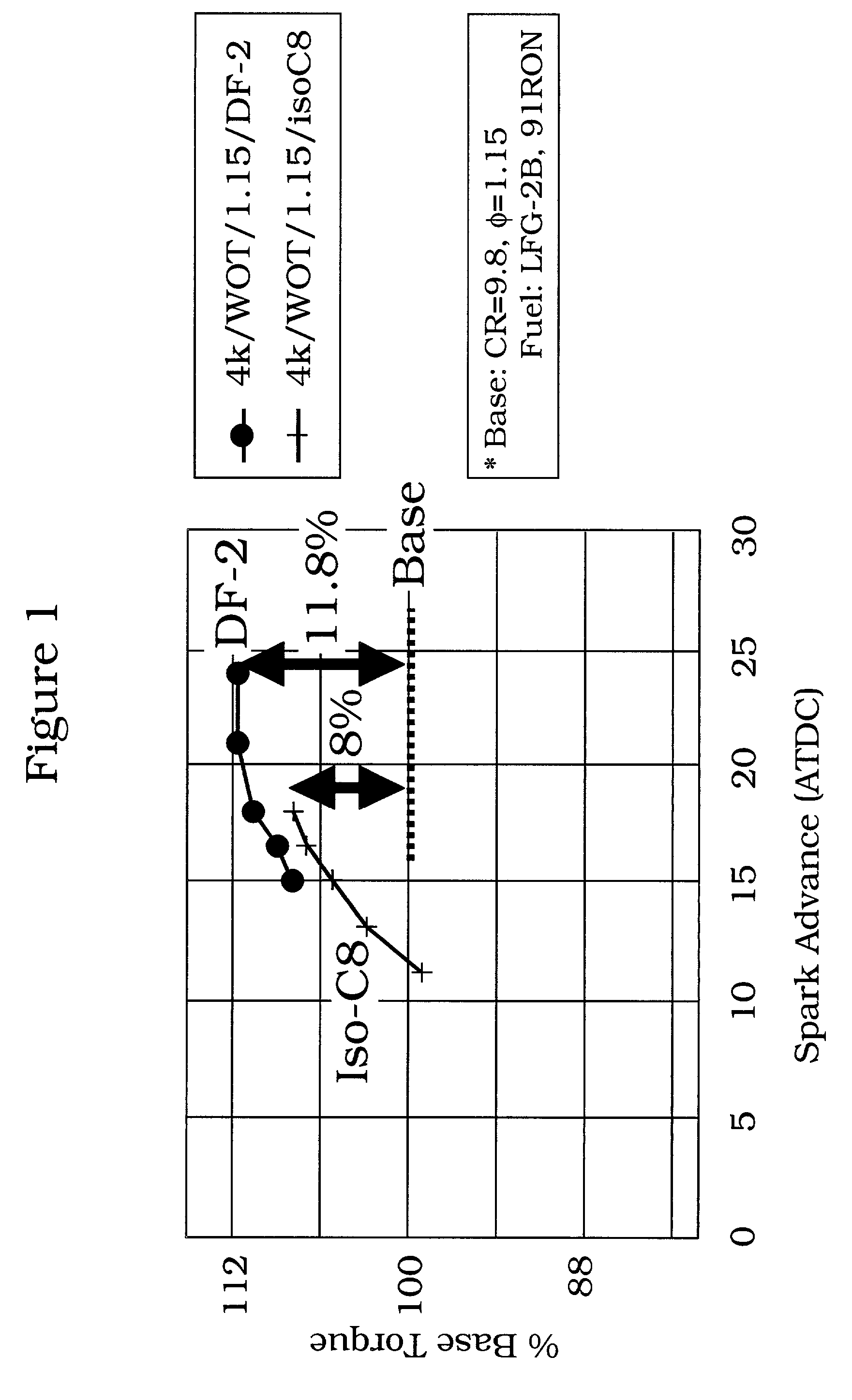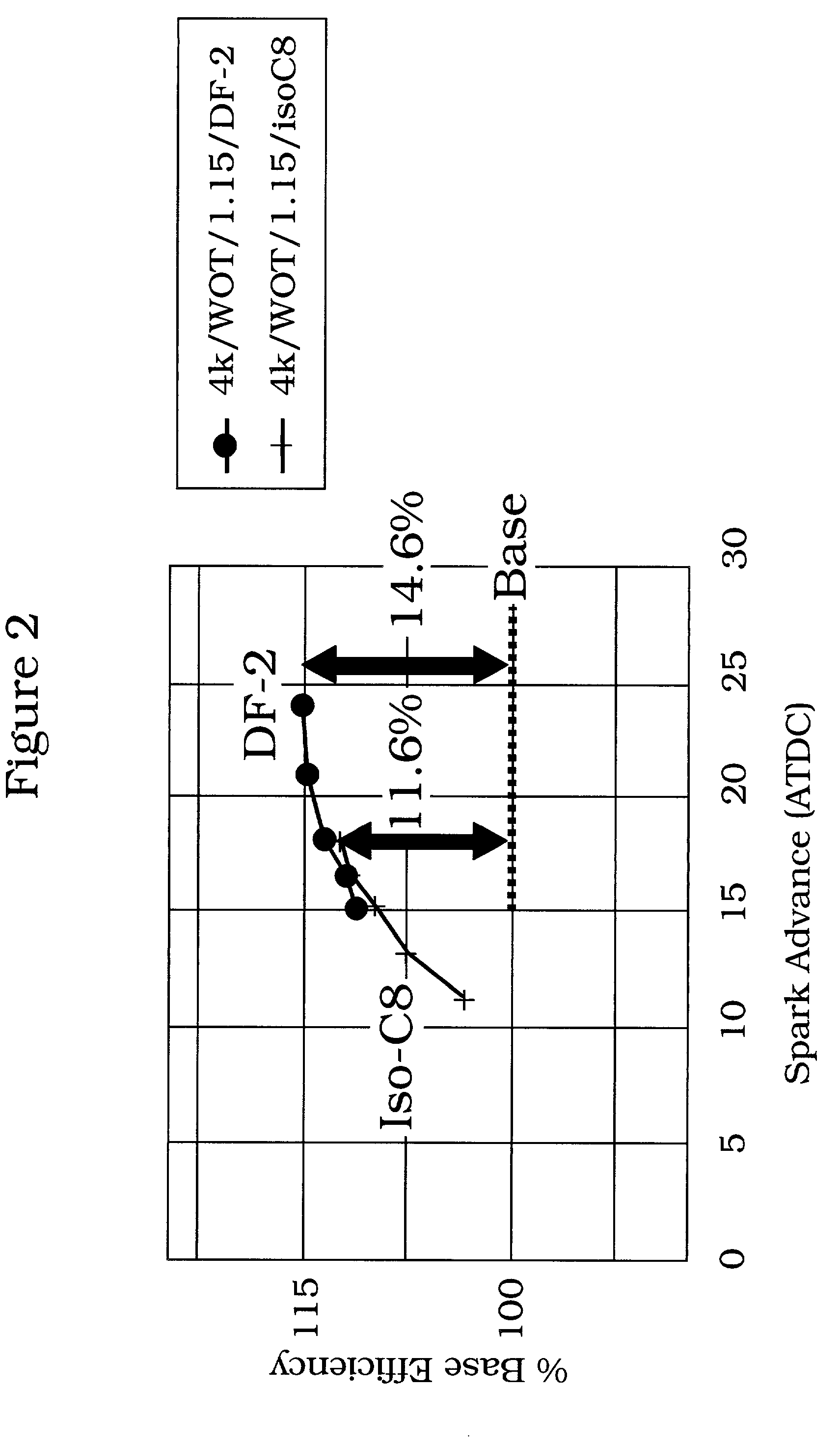Tuning fuel composition for driving cycle conditions in spark ignition engines
a technology of spark ignition engine and fuel composition, which is applied in the direction of fuels, machines/engines, mechanical equipment, etc., can solve the problems of limited use of high compression ratio spark ignition engine, damage to the engine, and damage to the overall performance, so as to maximize the engine thermal efficiency and prevent knocking
- Summary
- Abstract
- Description
- Claims
- Application Information
AI Technical Summary
Benefits of technology
Problems solved by technology
Method used
Image
Examples
example 1
[0046]The effects of a high octane, high knock-resistant, high burn rate fuel on combustion efficiency and performance were investigated in an in-line 4-cylinder (2.0 L displacement) DOHC 4 valve / cylinder direct injection spark ignition engine with a shell-shaped piston cavity, a straight intake air port, and a fan-shaped fuel spray. The engine was operated at high load / wide open throttle (WOT) at a compression ratio of 13.0. The base fuel was pure iso-octane with RON=100. The test fuel, called “DF-2” was comprised of 60% toluene, 33% iso-octane, and 7% n-heptane (measured RON=103). The fuel properties are listed in Table 1. Both fuels were combusted under the following conditions: engine speed=4000 rpm, fuel / air ratio (φ)=1.15, spark advance timing=11–24 degrees before top dead center (BTDC). In this example and the others that follow, the injection quantities of the fuel are adjusted so as to maintain equivalent total heating values
[0047]
TABLE 1FUEL PROPERTIES FOR WOT TESTSTest Fu...
example 2
[0053]The effects of a low octane, low autoignition-resistant, high burn rate fuel on combustion efficiency and performance were investigated the same in-line 4-cylinder (2.0 L displacement) DOHC 4 valve direct injection spark ignition engine described in Example 1. The engine was operated at various low and moderate load conditions at a compression ratio of 9.8 and 13.0. The base fuel was a commercial Japanese regular gasoline, named LFG-2B, with a RON value of 91.7. The low octane test fuel, named DF-1, was comprised of 68% iso-octane, 22% n-heptane, and 10% toluene (measured RON=83.8). The fuel properties are shown in Table 3:
[0054]
TABLE 3Fuel PropertiesDF-1Test FuelMeasuredCalculatedRON91LFG-2BDensityp / cm3 @ 15 C.0.70910.70940.69310.7358RON—83.88079191.7NON—82.2?9182.7LHVk / g43.9144.543.0H / Cmol / mol2.1542.1122.251.87A / F stoich14,90015.114.7Viscositymm 2 / s @0.60330 C.DistillationIBPDeg C.95.0Approx.31.699T5Deg. C.98.042.5T10Deg C.98.050.5T20Deg C.98.562.0T30Deg C.98.572.5T40Deg C.9...
example 3
[0058]The effects of a low octane, low autoignition-resistant, high burn rate fuel on combustion efficiency and performance have been investigated at a different region of the driving cycle in the same in-line 4-cylinder (2.0 L displacement) DOHC 4 valve direct injection spark ignition engine described in Examples 1 and 2. The engine was operated at an engine speed of 3000 rpm and fuel / air ratio of φ=0.56, which is located on a different part of the speed / load map than the engine conditions described in Example 2. The engine was operated at a compression ratio of 9.8 and 13.0. The base fuel was a commercial Japanese regular gasoline, named LFG-2B, with a RON value of 91.7. The low octane test fuel, named DF-1, is the same fuel described in Example 2, and is comprised of 68% iso-octane, 22% n-heptane, and 10% toluene (measured RON=83.8). The fuel properties are shown in Table 3: As was observed under the engine operating conditions of Example 2, significantly lower NOx and smoke emis...
PUM
| Property | Measurement | Unit |
|---|---|---|
| compression ratio | aaaaa | aaaaa |
| compression ratio | aaaaa | aaaaa |
| compression ratio | aaaaa | aaaaa |
Abstract
Description
Claims
Application Information
 Login to View More
Login to View More - R&D
- Intellectual Property
- Life Sciences
- Materials
- Tech Scout
- Unparalleled Data Quality
- Higher Quality Content
- 60% Fewer Hallucinations
Browse by: Latest US Patents, China's latest patents, Technical Efficacy Thesaurus, Application Domain, Technology Topic, Popular Technical Reports.
© 2025 PatSnap. All rights reserved.Legal|Privacy policy|Modern Slavery Act Transparency Statement|Sitemap|About US| Contact US: help@patsnap.com



